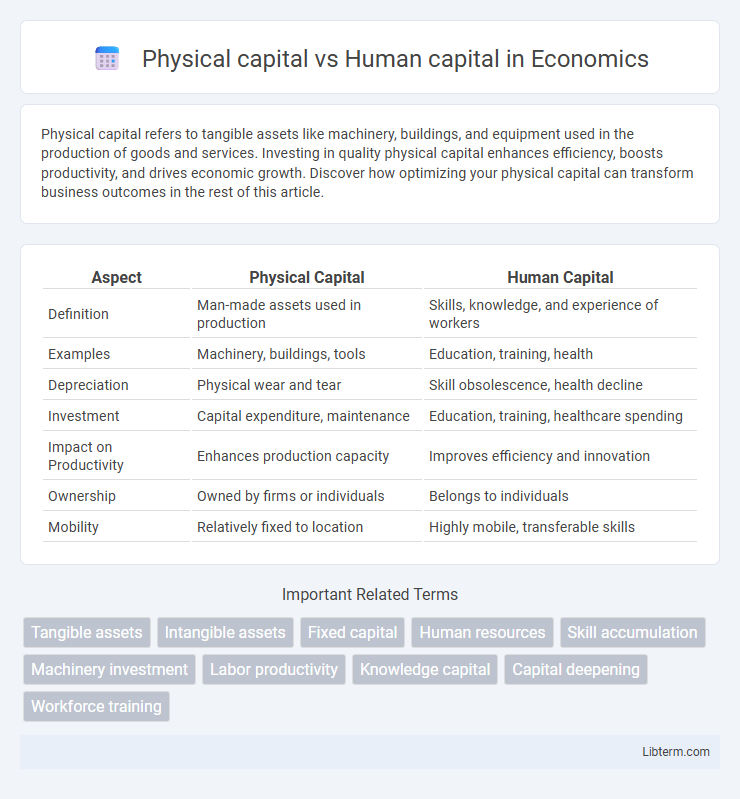Physical capital refers to tangible assets like machinery, buildings, and equipment used in the production of goods and services. Investing in quality physical capital enhances efficiency, boosts productivity, and drives economic growth. Discover how optimizing your physical capital can transform business outcomes in the rest of this article.
Table of Comparison
| Aspect | Physical Capital | Human Capital |
|---|---|---|
| Definition | Man-made assets used in production | Skills, knowledge, and experience of workers |
| Examples | Machinery, buildings, tools | Education, training, health |
| Depreciation | Physical wear and tear | Skill obsolescence, health decline |
| Investment | Capital expenditure, maintenance | Education, training, healthcare spending |
| Impact on Productivity | Enhances production capacity | Improves efficiency and innovation |
| Ownership | Owned by firms or individuals | Belongs to individuals |
| Mobility | Relatively fixed to location | Highly mobile, transferable skills |
Introduction to Physical and Human Capital
Physical capital refers to tangible assets like machinery, buildings, and equipment used in production, while human capital encompasses the skills, knowledge, and experience possessed by individuals. Investment in physical capital boosts productivity by enhancing technological capacity, whereas human capital investment improves labor quality and innovation potential. Both forms of capital are fundamental drivers of economic growth, with physical capital providing the tools and infrastructure and human capital delivering the expertise and creativity necessary for efficient utilization.
Defining Physical Capital
Physical capital refers to tangible assets used in the production process, such as machinery, buildings, tools, and infrastructure. These assets enhance productivity by enabling efficient manufacturing, transportation, and service delivery. Investment in physical capital directly impacts economic growth by increasing the capacity and quality of goods and services produced.
Defining Human Capital
Human capital refers to the economic value of a worker's experience, skills, education, and abilities that enhance productivity and innovation. Unlike physical capital, which includes tangible assets such as machinery, buildings, and infrastructure, human capital represents intangible assets embedded in individuals. Investments in human capital, such as training and education, directly impact economic growth by improving labor quality and efficiency.
Key Differences Between Physical and Human Capital
Physical capital refers to tangible assets like machinery, buildings, and equipment used in production, while human capital encompasses the skills, knowledge, and experience possessed by individuals. Physical capital is quantifiable and depreciation-prone, whereas human capital involves continuous investment through education and training, impacting productivity and innovation. The key difference lies in physical capital being a static asset, whereas human capital evolves and enhances organizational growth dynamically.
Role of Physical Capital in Economic Growth
Physical capital, including machinery, infrastructure, and technology, plays a crucial role in economic growth by enhancing production efficiency and scalability. Investment in physical capital increases a country's productive capacity, enabling higher output and supporting industrial expansion. Improved physical capital assets also attract foreign investment, stimulate innovation, and contribute to sustained increases in GDP.
Impact of Human Capital on Productivity
Human capital significantly boosts productivity by enhancing workers' skills, knowledge, and experience, leading to more efficient and innovative labor. Unlike physical capital, which involves tangible assets like machinery and infrastructure, human capital contributes to adaptability and problem-solving capacity in dynamic markets. Investments in education, training, and health improve cognitive abilities and motivation, directly increasing output per worker and driving economic growth.
Investment Strategies: Physical vs Human Capital
Investment strategies in physical capital prioritize acquiring machinery, infrastructure, and technology to enhance production capacity and operational efficiency. Human capital investment strategies focus on education, training, and health to improve workforce skills, productivity, and innovation potential. Balancing investments in physical and human capital drives sustainable economic growth and competitive advantage.
Measuring Returns on Physical and Human Capital
Measuring returns on physical capital involves evaluating the productivity and profitability of tangible assets like machinery, buildings, and equipment through metrics such as return on assets (ROA) and capital expenditure efficiency. Returns on human capital are assessed by examining workforce productivity, employee skill development, and the impact of training programs on organizational performance, often using indicators like increased earnings, reduced turnover, and enhanced innovation. Both forms of capital require precise quantitative analysis to optimize investment decisions and maximize overall economic value.
Challenges in Balancing Both Capitals
Balancing physical capital and human capital presents significant challenges, including the difficulty of allocating financial resources efficiently between infrastructure investments and workforce development programs. Organizations often struggle to quantify the long-term returns on human capital compared to tangible assets, complicating strategic planning and budgeting decisions. Furthermore, rapid technological advancements require continuous employee upskilling, increasing the pressure to invest simultaneously in modern equipment and comprehensive training initiatives.
Conclusion: Integrating Physical and Human Capital for Sustainable Growth
Integrating physical capital and human capital drives sustainable economic growth by enhancing productivity and innovation. Investments in infrastructure and technology must be matched with education and skill development to maximize returns. A balanced approach leveraging both asset types creates resilient economies capable of long-term development and adaptability.
Physical capital Infographic

 libterm.com
libterm.com